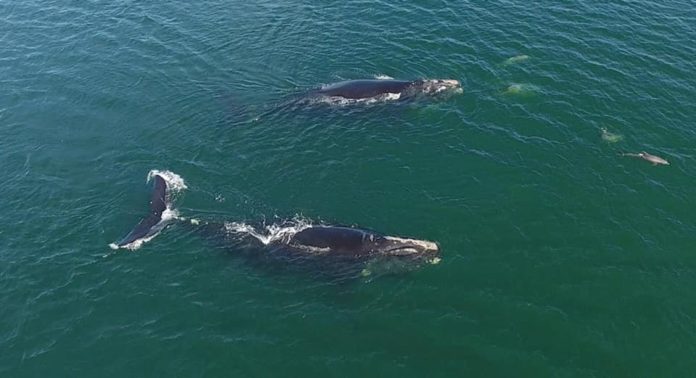The first right whales of this year’s calving season have been spotted off the coast of South Carolina. A crew with Outcast Sport Fishing spotted the whales while on a fishing expedition off the Beaufort County coast on Wednesday.
The crew posted on Facebook and said, “Saw a few dozen dolphin schooling, sent the drone over to take a look and found a couple of Right Whales. Unexpected addition to the charter as they swam right passed us.”
NOAA surveys to spot the endangered mammal have not started yet, but will in the coming weeks.
Biologist Barb Zoodsma with the National Oceanic and Atmospheric Administration Fisheries said boaters who see whales need to back away and leave them alone. Repeated encounters with humans are an added strain on them as they struggle to survive.
“It’s hard to do, these are awesome animals,” she said to GBP Radio News. “It’s hard to do but we just can’t love them to death. We’ve just got to give them space.”
Right whales endangered
The NOAA Fisheries reports that the North Atlantic right whale is one of the world’s most endangered large whale species, with only about 400 whales remaining. Right whales are baleen whales, feeding on shrimp-like krill and small fish by straining huge volumes of ocean water through their baleen plates, which act like a sieve.
By the early 1890s, commercial whalers had hunted right whales in the Atlantic to the brink of extinction. Whaling is no longer a threat, but human interactions still present the greatest danger to this species. Entanglement in fishing gear and vessel strikes are among the leading causes of North Atlantic right whale mortality.
Zoodsma, who has worked on right whales with the NOAA for over 20 years, said that there were only 94 breeding female right whales as of February 2018. “You don’t have to be Einstein to figure out that’s a bad situation,” she said.
On top of a lack of births, the right whale population has experienced an unsettling number of deaths. A technical memorandum issued by NOAA in September 2018 said that 19 right whales had died in 2017 and 2018.
Only 5 calves were born during that same period.
According to that same NOAA report, “an encounter with fishing gear is the most frequent cause of documented right whale serious injuries and deaths in recent years.” For the 19 recent whale deaths, NOAA could determine a cause of death for 10. And of those 10 fatalities, five were caused by ship strikes and five were caused by entanglement in fishing gear.
One study cited by NOAA showed that nearly 85 percent of right whales have been entangled in fishing gear. For 59 percent of right whales, it has happened twice. And the number of entanglements has been trending upward.
A dwindling population
The NOAA memorandum says right whales, like other large whales, live for a long time and can breed multiple times over a lifetime. That makes them resilient. But the memo also points out the obvious fact that if a species fails to replace its dead with new births over time, it will have a difficult time recovering a dwindling population.
So reproduction – or rather, a lack of reproduction – is a major area of concern for researchers. And for reproduction, healthy mothers are required. According to NOAA, right whales now have greater distances to travel from their feeding grounds, which have shifted farther north, down to the areas off the coasts of South Carolina Florida and Georgia where their calving grounds are.
People who spot a right whale should also call 1-877-WHALE-HELP so NOAA can alert other ships in the area.
Last year, the first right whale calf in two years was spotted. We would love to see more of them, and pray that the species makes a comeback.
Here’s a video post on Facebook from the folks at Outcast Sport Fishing.










